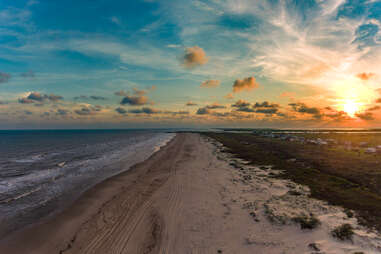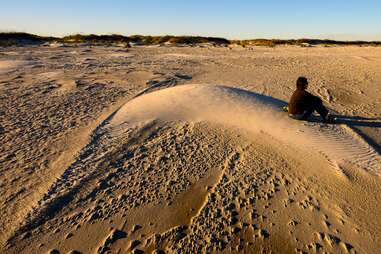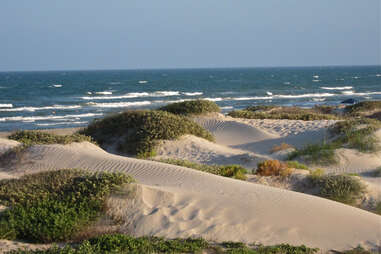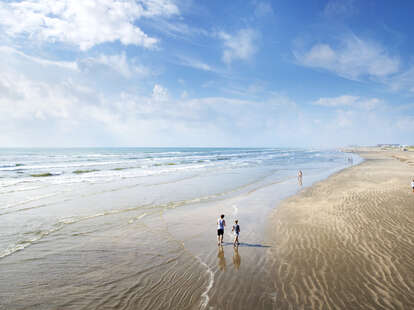Get to Know the Tropical Islands Lingering Just Off the Texas Coast
The Barrier Islands are kind of like the Florida Keys of Texas.
When most folks think of Texas in the summertime, visions of barbecue and Lone Star-shaped swimming pools might come to mind—but how about dolphins, rocket launches, and sandcastles the size of actual castles? The state’s barrier islands might surprise you.
What the Keys are to Florida, the barrier islands are to Texas: A 234-mile string of islands that hug the Gulf of Mexico coast, made primarily of sand built up over thousands of years from tidal ebb and flow, ranging in size from four miles to the largest barrier island on Earth. There are seven main islands in total, and just like Snow White’s Seven Dwarfs, each one has a totally distinct personality, from the touristy trappings of Galveston to the utter solitude of San Jose.
No matter your summer beach vibe of choice, Texas’ barrier islands deliver. Want some R&R on a remote beach populated almost exclusively by seagulls? You got it. Want to go kayaking in a national park? That’s a distinct possibility. Want to eat foot-long corn dogs and “mermaid soup”? You can and you should—and rest assured no mermaids were harmed in the making of either of those delicacies. Here’s your guide to Texas’ barrier islands.

Galveston
The northernmost barrier island, and by far the most popular with more than 7 million annual visitors, Galveston’s reputation as a summertime beach destination for Texans can largely be chalked up to its proximity to nearby Houston. Although it has somewhat of a campy reputation thanks to its Pleasure Pier boardwalk, eccentric mini golf courses, sea turtle statues in Lisa Frank colors, and pyramid-shaped aquarium, giving it sort of an Atlantic City of the South aesthetic, Galveston actually has a lot going for it (including some seriously excellent fish tacos). The 27-mile island is Texas’ quirkiest barrier island, teeming with endearing kitsch, historic architecture, and larger-than-life nautical lore (you can learn all about the island’s pirate history and legendary figures like Jean Lafitte).
The most hard-to-miss attraction, the Galveston Island Historic Pleasure Pier, is a mammoth boardwalk lined with carnival games and enough rides to fill a theme park, including the Iron Shark Rollercoaster and the Pirate’s Plunge flume ride. For something a bit more subdued, The Grand 1894 Opera House is an ornate institution, home to popular productions like Charles Dickens’ A Christmas Carol. The theater harkens to the island’s earliest days, when Galveston first emerged as a primary shipping and immigration port in the 1800s.
Nearby is The Strand, Galveston’s historic, bayside district filled with Victorian and Greek Revival architecture. You'll also find the tall ship Elissa, an 1877 vessel that now serves as a floating museum of maritime history. Further south on the island, Jamaica Beach offers a quieter reprieve from the touristy clamor, for those looking to soak up the sun without being cast under the shadow of the Galaxy Wheel.
Follet’s Island
Next up on the coastal roster—and basically the antithesis of Galveston in terms of hustle and bustle—Follet’s Island stretches along 13 miles between the San Luis Pass and Surfside Beach, a smaller, largely untouched and undeveloped landscape, save for some remote beach houses that act as the ideal rental for those looking for some zen.
The entire island is one big beach, most of which is quiet and wide open, providing ample opportunity for swimming, surfing, jet skiing, fishing, shell hunting, bach camping, and kayaking. It’s entirely free to visit and camp, and super cool date idea – beach horseback riding is welcome. Whatever your chill activity of choice, the sand dunes are off limits (that’s where the snakes hang, y’all) and make sure to be mindful of sea turtles; give them a wide berth if you spot one, and report sightings to local marine authorities by calling 1-866-TURTLE-5 to help protect them.

Matagorda Island
If you thought Follet’s Island was quiet, just wait until you see what’s next. Further south, Matagorda Island is the Lone Star’s most remote island, a 38-mile stretch of solitude only accessible by boat. A far cry from the shrieking thrill rides of Galveston, Matagorda—its name Spanish for “thick bush”—is largely comprised of the marshy Matagorda Island National Wildlife Refuge and State Natural Area.
For visitors who have a private boat, or are able to charter one, the car-free island is a beachy bastion for rugged campers willing to forgo the niceties of electricity and running water. As wild as a season of Survivor, this is an undeveloped place preserved for primitive activities like saltwater fishing, birding, and in-season hunting. For those with a valid hunting license, around 20,000 acres of land are open to deer and waterfowl, just as long as you keep in mind that whooping cranes, which occasionally flock to the area, are endangered and protected. At night, thanks to its remoteness and lack of light pollution, stargazing is a popular pastime out here, too.

San Jose Island
Equally as untouched as Matagorda, yet decidedly easier to access, San Jose Island lies immediately north of populated Port Aransas on Mustang Island, where a jetty takes visitors back and forth all day. Bring your own bait and beer and basque in its 21 miles of primitive beachfront, known for its excellent fishing for redfish and trout (especially off the craggy edge of the North Jetty) and endless beach combing opportunities for seashell groupies. Since it’s entirely protected as a sanctuary for wildlife, cars are also prohibited here. Fun fact: While you won’t see cars, you may see wild cows roaming the beach thanks to the island’s history as a former ranch.
Though quiet and unsettled, St. Joe, as it's called by locals, is teeming with Texas history. It was the first site to fly the American flag on Texas soil, when a lieutenant swam ashore from the USS Alabama and planted it in the sand in 1845. A short-lived town on the island, called Aransas, was razed by Union forces in the Civil War. In 1935, wealthy oil magnate Sid Richardson established a miles-long ranch and estate, where he once wined and dined with the likes of President Franklin D. Roosevelt. Said estate is long gone, but riches may or may not remain—legend has it that pirate Jean Laffite’s ghost still sits guard of his buried treasure there. Ahoy!
Mustang Island
While San Jose offers remote solitude and potential pirate riches, the island on the other side of Aransas Pass is a haven of seafood restaurants, margaritas, beachside festivals, and Easter-egg-colored cottages. Mustang Island draws in families and spring breakers alike, especially in the city of Port Aransas that comprises most of the 18-mile island. Lafitte used to frequent the island (arguably making him the original spring breaker), and though you likely won’t find his buried treasure here, you’re sure to find jewels of other kinds—award-winning sand sculptures, adrenaline-pumping jet ski jaunts, and all the shrimp and redfish you can comfortably eat.
For a town with a year-round population under 4,000, Port Aransas is surprisingly happening and delightfully quirky. Check out Texas SandFest, its annual springtime attraction rocking live music, carnival-style snacks from foot-long corndogs to funnel cakes, and epic sand sculptures right on the beach.
Further north on the island, there’s a beach where you can drive your car on the sand (a nice convenience for heavy-duty fishermen), while seafood-centric restaurants abound further inland. Try Lisabella’s, a beachy-chic restaurant found in the bougie community Cinnamon Shore (named for the fact that Port Aransas’ beaches look like they’re swirled with cinnamon). There you can pair on-trend espresso martinis with cheesy, baked oysters, pancetta-wrapped shrimp, and something called Mermaid Soup: a curried medley of lobster-coconut broth and shrimp—and, mercifully, no mermaids.
To fully immerse yourself in the action-packed island, though, you need to get out on the water, and by that we mean go on a guided jet ski romp. Gettin’ Salty Watersports takes visitors out into the bay and over to a couple of seashell-strewn islands, with lots of thrilling dolphin sightings along the way.

Padre Island
You may have heard of Padre Island. It’s not only Texas’ largest, it's also the largest barrier island in the world (NBD). Clocking in at a casual 113 miles, Padre Island is bookended by Corpus Christi and Padre Island National Seashore on the north and beach bars and theme park rides on the south. Naturally, an island larger than the state of Delaware is bound to have a wide array of attractions, and Padre Island is the kind of something-for-everyone enclave that runs the gamut from urban outings to all-natural tranquility and nature preserves.
Divvied into North Padre Island and South Padre Island, separated by the Port Mansfield Channel, the top half starts with Corpus Christi, the most populated area in the region. From the Selena Museum and the Texas State Aquarium to beachside breweries and guided tours aboard the USS Lexington, there’s no shortage of sights to drink in here. North Padre is also home to a national park site, Padre Island National Seashore, the longest stretch of undeveloped barrier island in the world and proof that that whole “everything’s bigger in Texas” slogan isn’t always an eye-rolling cliche. Ideal for those who want to tap into the “quiet life” travel trend, the 66-mile park is a mecca for fishing, kayaking, windsurfing, bird watching and sea turtle sighting, and primitive tent camping on the sands.
On the southern side of the channel, South Padre is known equally as a family-friendly getaway and a rowdy collegiate spring break staple. It's swarming with beach bars (including Clayton’s, the largest beach bar in the state), live music, carnival rides, an enormous water park, and Gravity Park, a theme park with some seriously intense attractions, including the “tallest reverse-bungee in the world.” You can also embark on a sunset standup paddleboard tour, take an adrenaline-blasting surfing, kiteboarding, or windsurfing lesson, and go on a seafood spree with peel-and-eat Gulf shrimp, grilled oysters, and blackened red snapper at hotspots like Dirty Al’s and Sea Ranch Restaurant. Of course, with this much mileage of coastline, there are plenty of beaches to choose from, too, like Isla Blanca Park and South Padre Bayside Beach.
Brazos Island
The last barrier island is also the teeniest. Also known as Brazos Santiago Island, this diminutive four-miler is home to Brazos Island State Scenic Park and its 217 undeveloped acres of seaside wilderness. You’ll find the peaceful retreat just north of the mouth of the Rio Grande, a serene spot for swimming, fishing, bird watching, hopeful dolphin-spotting, and camping.
Aside from that, the latest draw the area is known for is that it’s the launch facility for Elon Musk’s SpaceX, which set up shop on the Boca Chita peninsula. There, visitors can watch the world’s richest man—and the god of Twitter, we mean X—show off his billions by blasting rockets into space.
Brooke Viggiano Fischer is a Houston-based writer whose work has been published across the internet and in print with Thrillist, Chron, Houstonia, Houston Press and 365 Houston. When not searching every corner of Houston for the unicorn cool-but-not-too-cool patio bar, you can find her sharing her breakfast on Instagram @brookiefafa or on Twitter @brookeviggiano.
